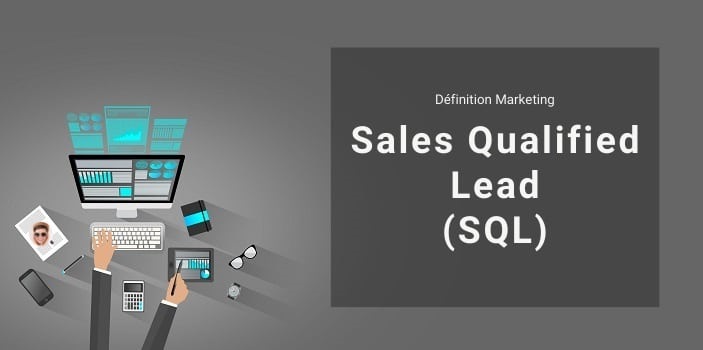Sales-qualified leads (SQLs) are potential customers or prospects assessed by the sales team and are determined to have a higher likelihood of converting into paying customers.
Let’s begin by learning how to identify Sales-qualified leads.
Identifying Sales-Qualified Leads

Identifying sales-qualified leads (SQLs) entails evaluating particular traits and behaviors of leads to ascertain their level of purchase readiness.
To ensure that the leads meet specific criteria indicating a higher likelihood of conversion, your marketing and sales teams must work together during the process. Here’s how you can identify SQLs:
Must Read: How Lead-To-Account Matching Transforms Sales Team Performance
1. Define The Ideal Customer Profile (ICP)
Collaborate with the marketing and sales teams to develop a thorough profile of your ideal customer. Consider the market, company size, job description, difficulties, and demographics.
2. Establish BANT Criteria
Budget, authority, need, and timeline are referred to as BANT. These essential criteria show whether a lead is prepared to make a purchase.
3. Interaction And Participation
Keep track of the lead’s interaction with your emails, webinars, content, and other marketing initiatives. A higher engagement rate suggests that your offerings are more appealing.
4. Lead Scoring
To rank leads according to their level of engagement and interest, give a numerical value to various actions and interactions (such as downloading content or attending webinars).
5. Behavioral Triggers
Identify actions that indicate buying intent, such as repeatedly visiting pricing pages, requesting a demo, or interacting with bottom-of-funnel content.
6. Website Analytics
Examine the website-use patterns of your leads. Pages about pricing, case studies, and product features show more interest in your products.
7. Demographic And Firmographic Data
To ascertain whether a lead fits your ICP, consider the industry, company size, location, and job title.
8. Lead Source
Analyze where the lead came from. Based on their intent and relevance, some lead sources might be more likely to produce SQLs than others.
9. Behavioral Scoring Models
Create more complex scoring models that consider a mix of behavioral, firmographic, and demographic information.
10. Sales And Marketing Alignment
Create a simple procedure for transferring leads from marketing to sales. Achieve agreement between the two teams on the standards that define SQLs.
11. Qualification Questions
Include qualification questions in your lead capture forms or during initial conversations to gather information about the lead’s needs and buying intent.
12. Manual Review
Have a review procedure where salespeople can manually determine and confirm whether a lead satisfies the required criteria.
13. CRM Integration
Track lead interactions and rank lead for sales outreach by integrating your customer relationship management (CRM) system with your marketing tools.
14. Regular Assessment
Regularly evaluate the success of your SQL identification procedure, and modify your standards in light of user feedback and data analysis.
Must Read: Does Salesforce Own Slack?
Converting Sales Qualified Leads

Strategic communication, individualized engagement, and attending to their needs and concerns are necessary to turn SQLs into paying customers.
Keep in mind that the criteria for identifying SQLs can change depending on your industry, the complexity of your product or service, and your target market. Regular communication between your marketing and sales teams is crucial to optimize your SQL identification process and guarantee a smooth transition from marketing to sales activities.
1. Recognize Their Needs
Review your details regarding the lead’s requirements, challenges, and pain points. This will enable you to adjust your strategy to meet their particular needs.
2. Individualized Reach
Send a personalized message to the lead outlining their problems and how your solution can solve them. To demonstrate that you are paying attention to their interests, refer to any prior interactions or content they have interacted with.
3. Educate People And Add Value
Share pertinent case studies, success tales, and other materials that show how your solution has helped organizations with similar needs. Offer opinions and informational materials highlighting your sector expertise and the value you can add.
4. Provide Product Presentations
If appropriate, offer to give a thorough product demonstration that illustrates how your solution functions and addresses its unique problems.
5. Highlight Benefits And ROI
Clearly outline the benefits they will gain from using your solution, including potential return on investment (ROI) and improvements to their business processes.
6. Increase The Feeling Of Urgency
Insist on the importance of acting now rather than waiting. Outline any potential repercussions of delaying their choice.
7. Offer Prices And Packages
Share pricing information and available packages, as appropriate. Please verify that the cost reflects the benefit they will receive from your solution.
8. Get Decision Makers Involved
Obtain input from all parties taking part in the decision-making process. Consider the issues and goals of each stakeholder to ensure a thorough strategy.
9. Define A Clear Next Step
Outline the following steps: contract signing, implementation schedules, and any paperwork needed.
10. After-Action And Persistence
Be persistent while respecting their preferences and timeline, and keep consistent communication.
11. Overcome Budgetary Issues
Offer flexible payment plans or emphasize the long-term benefits and potential cost savings your solution can provide if money is an issue.
12. Cite Social Evidence
To establish credibility and trust, provide happy clients’ references, case studies, and endorsements.
13. Pilot Phase Or Trial
Offer a trial period or pilot phase so that they can see the advantages of your solution for themselves.
14. Complete The Sale
Once you have eased their worries, shown them your value, and gotten their approval, enlist their cooperation in moving forward.
Remember that establishing trust and providing value is essential throughout the conversion process. Even after the sale, keep the relationship going by paying attention to the lead’s input, offering exceptional customer service, and focusing on relationship-building.




